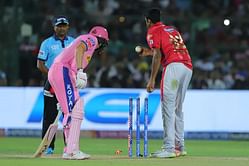In order to inject transparency, excitement and the safety of the players in the limited overs cricket, the International Cricket Council (ICC) has been formulating several rules over the years. Recently, the world cricket-body introduced several modifications in the shorter formats of the game.
![]()
Field Restrictions
In ODI, the fielding side can deploy maximum two fielders outside the 30-yard circle in the mandatory powerplay overs i.e. first ten overs of an innings. From 11 to 40 overs, maximum four fielders are allowed outside the ring, while it increases to maximum five fielders in the last ten overs.
In T20I, two fielders are allowed outside the ring in first six overs of mandatory powerplay.
Revised Playing Conditions
During an interrupted ODI, the revised number of overs to be bowled is decided on the basis of 14.28 overs per hour rate, inclusive of the drinks intervals. While, in case of T20I, a fixed time is finalized before calling off the game on a rate of 14.11 overs per hour.
During a curtailed ODI, the total numbers of overs are divided by five to fix the maximum overs delivered by a bowler. To maintain a balance, additional overs are allowed to the maximum number per bowler. In a recent rule-maneuver, a bowler can deliver maximum two overs if the T20I is reduced to ten overs of less than ten overs.
Unless a twenty overs-side match takes place, any ODI is aborted and in T20I the criteria is a minimum five overs-side match.
New Balls
In ODIs, the fielding side can use two new balls from alternative ends for an innings. However, if the match reduces to 25 overs or less than 25 overs, only one new ball will be entertained.
In case of a T20 international, the fielding side will be presented the new ball only once, that is before the commencement of the innings.
Thickness of the Willow
To maintain an equilibrium between bats and bowls, ICC has restricted the thickness of the willow. While the edge of the bats cannot be thicker than 40 millimeters, the entire depth can’t exceed 67 millimeters-mark.
Absence from the field
In both the ODI and T20I formats, if a player’s absence from the field exceeds eight minutes, that player will not be allowed to bowl for a restricted period of time, which will be same with the length of the playing time for which the player was absent (referred as ‘Penalty Time’). The player can further bowl only after reintroduction in the field or the team has subsequently been batting.
The restricted time period carries forward to the next innings of the match as well. The player will not be allowed to bat until his/her remaining length of time expires. However, the penalized player can bat if their team lose five wickets within the Penalty Time.
While “Penalty Time” for each player in T20I should not exceed more than 40 minutes, it should be to be restricted to 120 minutes in ODI.
‘Maintain’ Boundaries
In the recent amendment, the ICC proposed that the airborne fielders have to touch the ball taking off inside the boundary rope or it will be declared as a boundary. If a fielder touches any object behind the boundary line, like touching the ball, including fellow fielder, the outcome will be a boundary.
Decision Review System
Recently, the ICC allowed the usage of Decision Review System (DRS) in T20 internationals and every team will get one unsuccessful review per innings. While in the ODIs, ICC permits two unsuccessful reviews per innings. Teams will not lose the review if the appeal is dismissed for ‘umpire’s call’.
Run-outs
If a batsman grounds his bat or part of the body beyond the crease before the stumps are broken and accidentally dislodges with his bat or the bat remains in the air, the batsman will be adjudged ‘not out’. This rule is also applicable for stumpings.
How DLS Works
The Duckworth-Lewis-Stern (DLS) is a matter of great importance in the limited overs cricket. During the start of the innings, two resources are taken into consideration.
One is the total number of deliveries and ten wickets. As the batting innings progress, those resources decrease eventually become nil after full-quota of overs or losing ten wickets. The score is calculated on the basis of at what stage the game is interrupted, the remaining overs and wickets.









